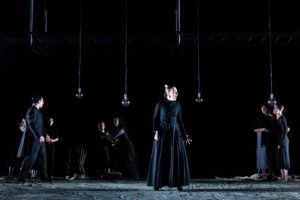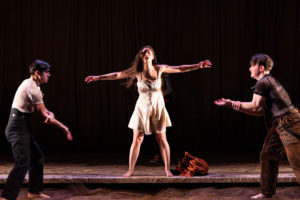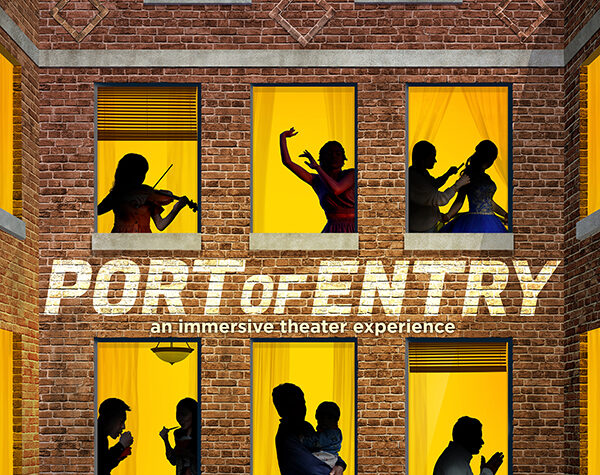
 [rating=2]“Blood Wedding”, directed by Ismael Lara, Jr., is a story with a gruesome theme that is needlessly hard to follow. The setting is rural Spain at roughly the turn of the 20th century, where one woman is loved by two men but in different ways. Leonardo (Theo Gyro) is married to his wife (Neno Martins); they have a child and one is on the way. But Leonardo lusts for the woman who was once his neighbor (Alexis Diaz-Waterman), and who is now a bride promised to another man (Esteban Ortiz-Villacorta). Unaware of her husband’s previous relationship with his neighbor, Leonardo’s wife insists that she and her husband attend her cousin’s wedding together. While the relationship between the groom-to-be and his bride-to-be is meant to be an “honest one”, her blood does not boil for him, and she is still fond of her former paramour. The demonic spirit motivates Leonardo to break his own wedding vows and run off with the bride on her wedding day. In this part of rural Spain, where knife wielding constantly takes place, a vendetta is launched. So when the bride acts on her passion, the groom, his family, and the community-at-large are out for blood. What makes this story different from most is that it is the bride who draws the knife, but I won’t reveal how or why it happens, because that is the climax of the show.
[rating=2]“Blood Wedding”, directed by Ismael Lara, Jr., is a story with a gruesome theme that is needlessly hard to follow. The setting is rural Spain at roughly the turn of the 20th century, where one woman is loved by two men but in different ways. Leonardo (Theo Gyro) is married to his wife (Neno Martins); they have a child and one is on the way. But Leonardo lusts for the woman who was once his neighbor (Alexis Diaz-Waterman), and who is now a bride promised to another man (Esteban Ortiz-Villacorta). Unaware of her husband’s previous relationship with his neighbor, Leonardo’s wife insists that she and her husband attend her cousin’s wedding together. While the relationship between the groom-to-be and his bride-to-be is meant to be an “honest one”, her blood does not boil for him, and she is still fond of her former paramour. The demonic spirit motivates Leonardo to break his own wedding vows and run off with the bride on her wedding day. In this part of rural Spain, where knife wielding constantly takes place, a vendetta is launched. So when the bride acts on her passion, the groom, his family, and the community-at-large are out for blood. What makes this story different from most is that it is the bride who draws the knife, but I won’t reveal how or why it happens, because that is the climax of the show.
The play is based on the original Spanish story by Federico García Lorca, translated by Caridad Svitch. But unfortunately, not everything in this show was translated into English, especially conversations between the groom’s mother (Danielle Llevada) and her son. With my rudimentary Spanish, I knew that much of what was said was not being translated for the audience’s benefit. As I could tell from discussions in the lobby afterwards, those not already familiar with the Spanish language were not too happy. Basically, this production works better for those audience members who are bilingual.
García Lorca once wrote, “To burn with desire and keep quiet about it is the greatest punishment we can bring on ourselves.” He certainly makes the case for what can happen when people do not lead fulfilling lives and fail to be their authentic selves. I understand that the point being made is to change society: to give women more freedom to make their own decisions and to not accept the dictates of patriarchy. But considering that none of the characters are sympathetic and we see little or nothing of their personalities, we really do not care if the bride chooses Lover A or Husband B.
More to the point, the story could have been better humanized if we knew the characters’ names in addition to Leonardo. Most are noted by filial relationship: for example, the bride, the groom, the bride’s mother (Gabriela Furtado Coutinho), the bride’s father (Benjamin Jouras), etc. Not only does the lack of proper names make it difficult to refer to each of the characters, but it serves to dehumanize them. Having said that, I can offer up a likely reason for why all these characters go unnamed: When Leonardo chooses to have more than one woman, the focus is mainly on him and his desires and not on those of others. By flouting moral convention, he becomes the only “authentic” character, who lives according to his own rules and thus becomes the only one who truly counts in this story. He is a “superman”, who acts according to his will and above beyond existing social and cultural norms, as in the mode of Friedrich Nietzsche. So while García Lorca might see Leonardo as a hero who has broken free of social bonds, I see him as a cad, who doesn’t care which women or families he hurts or what the consequences of his actions are. To put this another way, Leonardo is uncaring about the fate of others, who still are subject to the mores of the existing social order. I do not find him to be a sympathetic character, because he takes advantage of women in the guise of fostering their independence from religious and moral convention. As a result, everybody’s life is ruined, including his own; and he ultimately dies for his indiscretion.
What is most redeeming about this show has to do with the production team’s efforts, beginning with the wonderful choreography by Emily Brooks! Through several sequences of dance numbers, she invents a fascinating way to depict the horrors of being tainted with blood and what it might mean to have a curse on the community and a vendetta against the two principals, who have given into temptation and are likely living a life of sin. Alaina Moore’s costume design is fantastic! At the beginning, all of the characters are mostly dressed in black and white with the exception of the bride-to-be, who wears clothing with various amounts of red in three separate costume changes; this includes her absolutely stunning and provocative wedding dress. There is the male costume that almost looks like a fish, with scales on it. The black dresses that the women wear at the reception and the groom’s off-white bolero outfit are especially grand. Tianxuan Chen’s set design with sand in the foreground and a more traditional stage platform in the middle ground is intriguing, and provides a canvas for Lara’s direction and for the work of intimacy and fight choreographer Micah Figueroa. I especially loved how the backdrop is removed the moment the wedding scene shifts from a sacred occasion into a catastrophe, to be replaced by a raw black background. The use of the rafters for the escaping couple to tread on is brilliant, as is having the two men placed well above the stage streaming blood in the form of a red ribbon. Their deaths are nicely depicted through the imaginative use of lighting, the bailiwick of lighting designer Avi Sheehan. It is spectacular to see the long tubular LED lights descend from the ceiling, surround the action, and change color when everything is in flux.
Of course, here in America today, we live in very different times in a very different culture than that of Spain at the turn of the 20th century. This reality might make it difficult to understand how revolutionary it was for somebody like Leonardo and the bride to willfully break with convention, some of which still exists today. That said, when see all the characters (with the possible exception of the bride) playing social roles more as caricatures and cardboard cutouts than as flesh and blood individuals, the story becomes uninteresting. In other words, their impersonality dilutes the larger message of the show, and we lose the audience.
“Action does not take the place of good character development,” were the first words spoken by my guest at the conclusion of “Blood Wedding.” I wouldn’t have phrased it exactly that way, but you get the picture.
“Blood Wedding” is playing through February 5, 2023, at the Josephine Louis Theater at Northwestern University’s Wirtz Center for the Performing Arts, 20 Arts Circle Drive, in Evanston.
Tickets range from $6 – $25.
Performance schedule:
 Friday, January 27 – 7:30 p.m.
Friday, January 27 – 7:30 p.m.
Saturday, January 28 – 7:30 p.m.
Sunday, January 29 – 2:00 p.m.
Thursday, February 2 – 7:30 p.m.
Friday, February 3 – 7:30 p.m.
Saturday, February 4 – 7:30 p.m.
Sunday, February 5 – 2:00 p.m.
A post-show conversation is scheduled for Thursday, February 2nd, with director Ismael Lara, Jr.
To purchase tickets, please go to: https://web.ovationtix.com/trs/pr/1128437 or visit the Wirtz Center box office, located in the Barber Theater lobby, 30 Arts Circle Drive (in the same building as the Louis Theater).
For more information about this show and other productions at the Wirtz Theater, visit: https://wirtz.northwestern.edu/.
For the latest COVID-19 requirements, see: https://wirtz.northwestern.edu/health-and-safety/. Note that proof of vaccination is not required at present, but everybody needs to wear a mask inside the theater. These protocols are subject to change at any moment.
To see what others are saying, visit www.theatreinchicago.com, go to Review Round-Up and click at “Blood Wedding”.






More Stories
“The Thanksgiving Play”
“Jump” reviewed by Julia W. Rath
“Judgement Day”